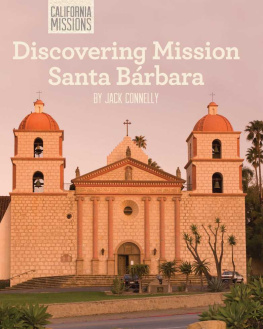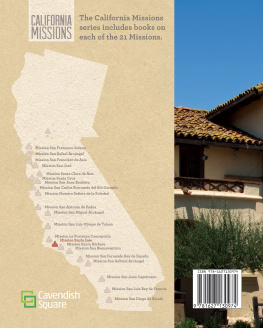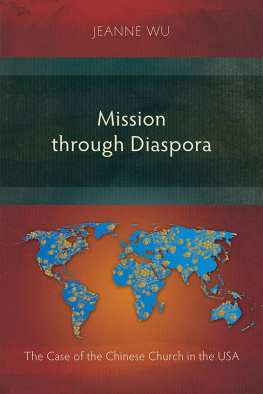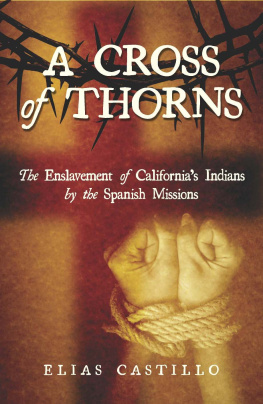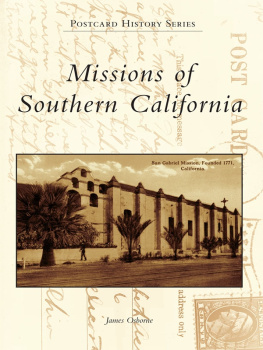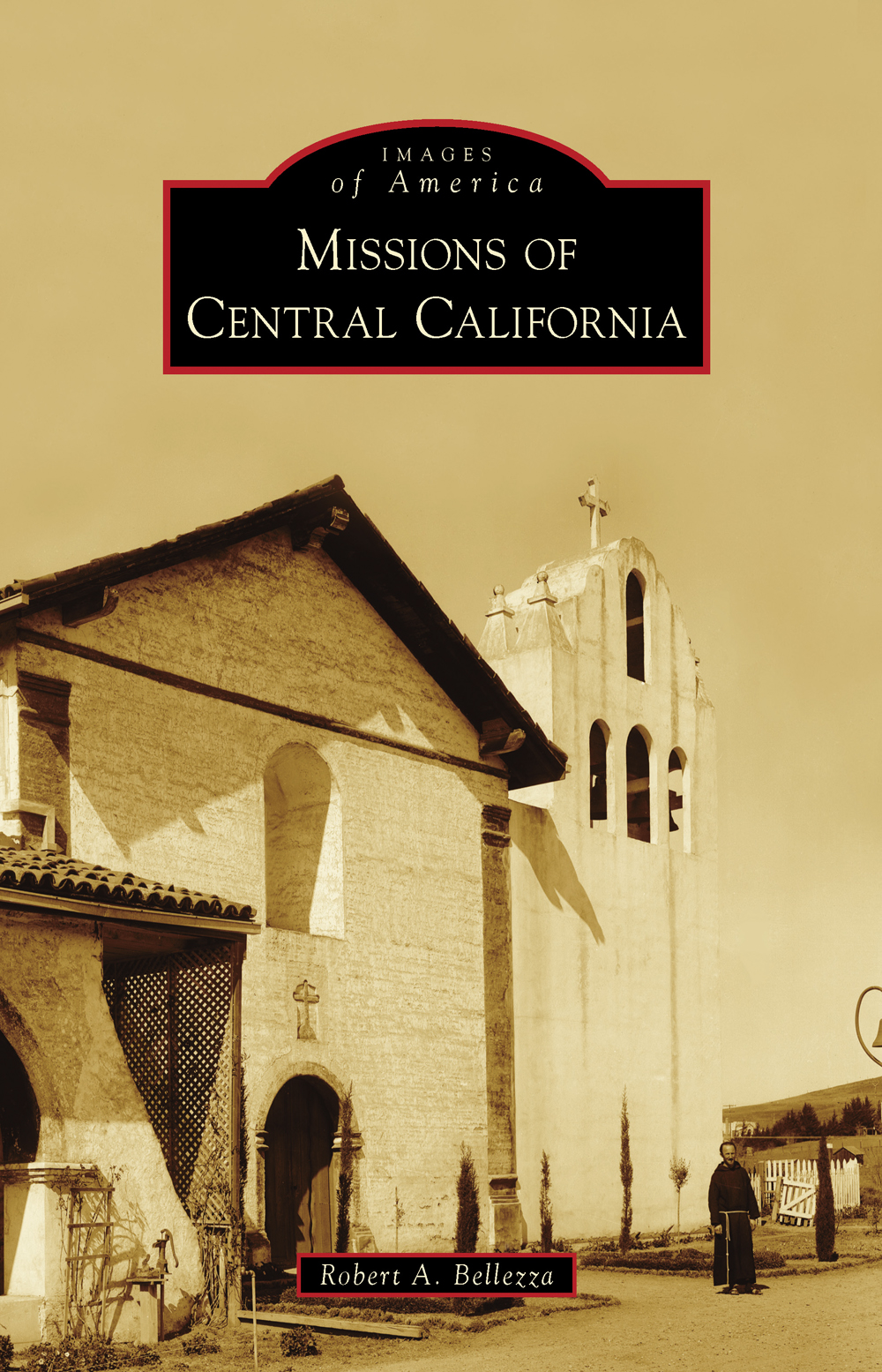
IMAGES
of America
MISSIONS OF
CENTRAL CALIFORNIA

Surrounded by Mission Santa Inss serene grounds yet living in a modern world, Fr. Vincent Kerwick shows a pensive mood around 1928 at the center of Californias earliest history in present-day Solvang. This 19th mission had been established in 1804 in the beautiful Santa Ynez River Valley, 45 miles northeast of Santa Barbara. (Anderson Family Collection.)
On the Cover: Old Mission Santa Ins, Virgen y Mrtir, is pictured around 1937 with its pastor, Father Kerwick. The mission, under the Capuchin Franciscan fathers management since 1924, has been completely restored and rebuilt along with most of the convento wing. The existing church was built in 1817 by Fr. Estvan Tpis, mission president of Californias Spanish missions. Considered one of the best examples of native Indian artistry, the mission still serves local Chumash and the neighboring community of Solvang. (Anderson Family Collection.)
IMAGES
of America
MISSIONS OF
CENTRAL CALIFORNIA
Robert A. Bellezza

Copyright 2013 by Robert A. Bellezza
ISBN 978-1-4671-9680-8
Ebook ISBN 9781439643297
Published by Arcadia Publishing
Charleston, South Carolina
Library of Congress Control Number: 2012952042
For all general information, please contact Arcadia Publishing:
Telephone 843-853-2070
Fax 843-853-0044
E-mail
For customer service and orders:
Toll-Free 1-888-313-2665
Visit us on the Internet at www.arcadiapublishing.com
Warm wishes to my brother Don, Elisabeth, and the family back on the east coast. I owe a valuable part of my early curiosity of history to those placid shores.

In 1603, upon landing along these shores during his historic voyage, Sebastin Vizcano named the harbor and waterway straights of the Channel Islands after legendary martyr Saint Barbara. In the legend, she was slain by her father, who then perished from a sudden lightning bolt. Revered over the centuries, Saint Barbara lives today as a symbolic icon of the Mission Santa Brbara and the surrounding community. (Authors collection.)
CONTENTS
ACKNOWLEDGMENTS
The Library of Congress Prints & Photographs Online Collection has supplied the majority of images within this volume and makes possible a review of Californias founding architectural landmarks practically lost through centuries of age, deterioration, and neglect. Californias mission buildings were rescued only after the majority had suffered irreversible weathering and ruin to the adobe walls. The Historic American Building Survey, employing the Civilian Conservation Corps (CCC) and photographers from the 1933 New Deal, documented the decay of the many iconic structures. Unless otherwise indicated, all images are courtesy of the Library of Congress, Historic American Buildings Survey/Historic American Engineering Record/Historic American Landscapes Survey.
By the beginning of the 20th century, efforts had been made to preserve the earliest missions, often built and decorated entirely by California natives. Several photographs within this volume are released for the first time from the authors collection and from the Anderson familys collection of vintage glass plates. A few noted select images are magic lantern slides made by the Charles Beseler Co. in or after 1905. My deepest appreciation goes to Sheila Benedict for her help with historical references on many central missions. Many up-to-date mission photographs featured in California Missions Past and Present: Touring El Camino Real are from my visits to each area. Special appreciation is given to Amy Perryman, associate publisher at Arcadia Publishing, for her guidance through the process and believing we could make it possible.
I am truly pleased this books release coincides with the 300th anniversary year of Fr. Junpero Serras birth. Miguel Josep Serra (Junpero was his chosen religious name) was born on November 24, 1713, in Petra, Majorca, one of the Balearic Islands, located some 150 miles off the coast of the Spanish mainland.
INTRODUCTION
THE CENTRAL MISSIONS
The earliest California missions had been constructed simply of mud, grass, and tule reeds, as was the custom during Father Serras years residing in the deep jungles of Mexico. Alta Californias fifth settlement, Mission San Luis Obispo de Tolosa, was founded in honor of the famous Saint Louis of Toulouse, consecrated on September 1, 1772, as the first of Central California. El Camino Real, or The Royal Road, had reached into uncharted regions of Alta California following Father Serras famous journey to meet supply ships in San Diego and then on to appear before the viceroy in Mexico City. Father Serra founded the Mission San Luis Obispo in a low plain first discovered by Gaspar de Portol and named by him Valley of the Bears. Grizzly bears had been observed and the enormous omnivores left immense mounds pawed up from foraging feasts north of Santa Maria. This led to good fortune for several soldiers exploring for food for mission colonies over three critical months. Nine thousand pounds of bear meat were delivered by a single hunting party and fed several missions. Supply ships coming into San Diegos port were unwilling to sail north to the Monterey harbor in early mission years, necessitating sending supply lines over land by mule pack trains. Mission San Luis Obispo de Tolosa had first been left under a single friar, Fr. Jos Cavaller, with five soldiers and two converted Baja Indians. This practice also helped to establish new estancias, or stations, providing a small adobe church and quarters at nearby rancherias. Father Serras initial vision included a single Channel mission near the presidio in Santa Barbara, but eventually several manifested, including Missions San Buenaventura, La Pursima, Santa Brbara, and Santa Ins. By 1774, Mission San Luis Obispo de la Tolosa had already survived three fires set by unfriendly natives as flaming arrows were shot directly into the adobes dry thatched roofing in the days hot sun. The mission fathers readily replaced the tule roofing with fired clay tiles and adopted this system at all mission settlements. Mission San Luis Obispo established outlying asistencias, the largest named Santa Margarita, a sub-mission built in 1787 that became a prosperous outpost. Near the location of Mission San Luis Obispo and set on a high plateau above todays Cuesta grade, it served a large concentration of Chumash Indians. The missions impressive stone foundations are still visible centuries later, but they were incorporated beneath the roof of a modern hay barn decades ago. The asistencia contained a chapel, altar, living quarters for the majordomo, storage areas for harvests, and lodging for travelers. By 1804, the neophyte faithful at Mission San Luis Obispo had recorded 2,000 baptisms and over 1,000 deaths. The missions settlement grew in both dimensions and productivity, and by 1820, native neophytes trained by Spanish craftsmen tended flourishing industries in agricultural trade. Over the years, Mission San Luis Obispo was elevated as one of six annual retreats that served all missionaries.
SHORES OF SERENITY
Father Serras ninth mission, founded on Easter Sunday 1782 and consecrated as Mission San Buenaventura in honor of the Italian Franciscan Saint Bonaventure (12181274), became the first Channel mission. As a second link in this chain, Mission Santa Brbara became the last dying wish of Father Serras life. After a long awaited approval, Gov. Felipe de Neve agreed to send needed missionaries to serve the California mission colonies from Mexico Citys Franciscan College of San Fernando. Father Serra had completed his lifes work and retired to Carmel, living only two years more. Fr. Francisco Palu, a longtime friend, companion, and biographer, became mission president briefly, then retired to Mexico following the demise of Father Serra in 1784. Father Palu recommended a new visionary, Fr. Fermn de Francisco Lasun, mission president of Baja California, to follow as third president. Father Lasun would found nine missions during the next decade. Mission Santa Brbaras first church had been built of adobe brick with red clay tile roofing at the Santa Barbara presidio and was dedicated on December 4, 1786, by Father Lasun. Mission Santa Brbaras existing massive stone face and Spanish Moorish-style fountain were completed in 1820 and were rebuilt in 1950; the second tower was completed in 1831. Devastating earthquakes occurred in 1812 and 1925, greatly affecting Mission Santa Brbaras structure and requiring major restoration. By 1842, by a decree of Pope Gregory XVI for a bishop as head of all the Californias, Fr. Garcia Diego was installed as head of the Baja and Alta California churches, residing at Mission Santa Brbara. Mission San Carlos Borromeo del Rio Carmelo had been abandoned, and the Queen of the Missions, Mission Santa Brbara, withstood the transition to Mexican laws. The mission remained continually active and home to Franciscan padres, building its esteemed church archive and library. The adjacent apostolic college and historic adobe buildings housed a monastery training Franciscans and was completed in 1856. The Colegio Franciscano, a boys school, opened in 1868. In 1901, St. Anthonys six buildings, integrated by a series of arcades, a cloister, a courtyard, and a patio, had been built adjacent to the mission complex to the north.
Next page

